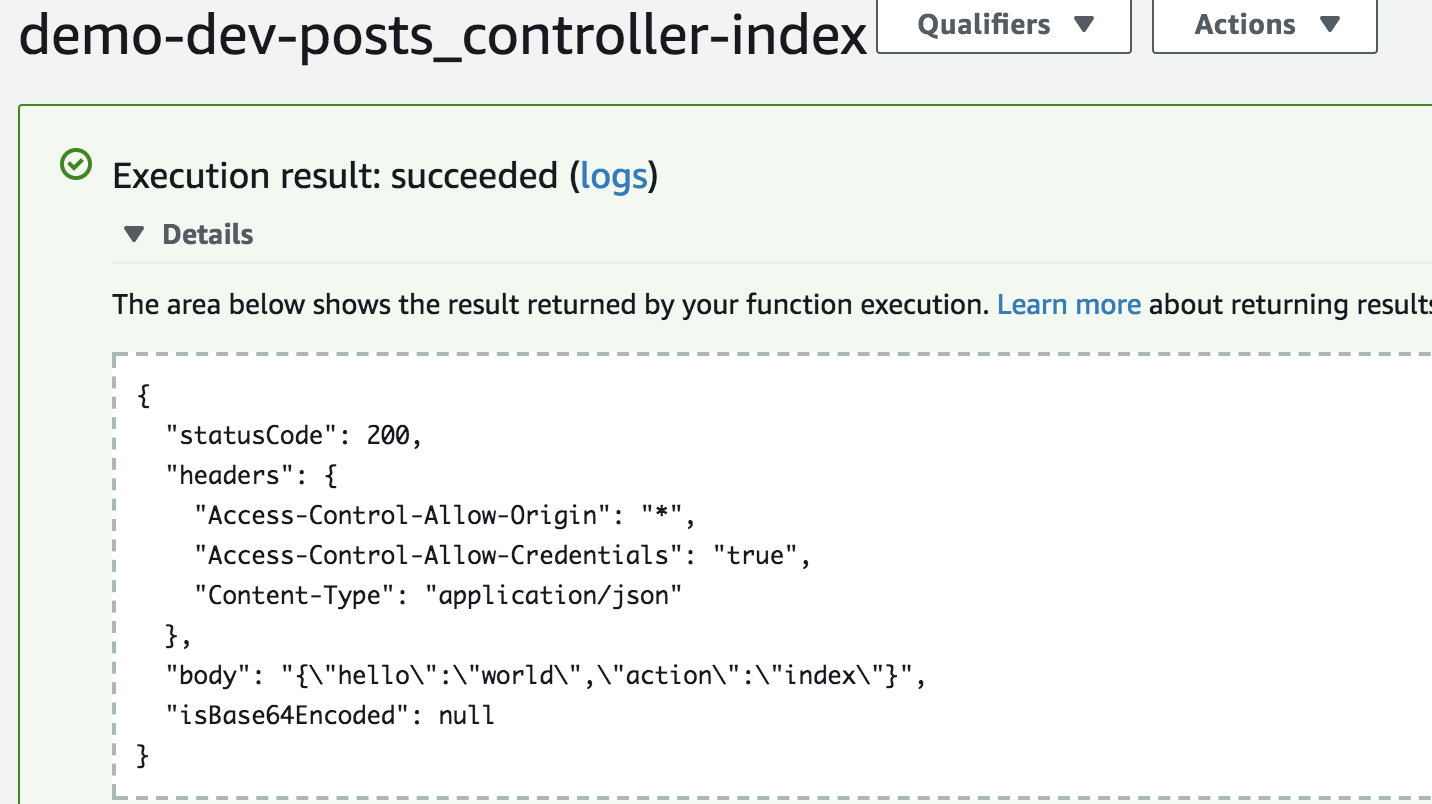README.md in jets-0.2.0 vs README.md in jets-0.5.0
- old
+ new
@@ -1,37 +1,136 @@
-# Jets
+<div align="center">
+ <link href="http://rubyonjets.com"><img src="http://rubyonjets.com/img/logos/jets-logo.png" /></img>
+</div>
-[](https://magnum.travis-ci.com/)
-[](https://codeclimate.com/)
-[](https://codeclimate.com/)
+
+[](https://circleci.com/gh/tongueroo/jets)
-To these the jets, run these commands:
+Ruby and Lambda splat out a baby and that child's name is Jets.
-TODO: Write a gem description
+## What is Jets?
-## Installation
+Jets is a Ruby Serverless Framework that allows you to create applications. It includes everything required to build an application and deploy it to on AWS Lambda.
-Add this line to your application's Gemfile:
+It is key to understand AWS Lambda and API Gateway to understand Jets conceptually. Jets maps your code to Lambda functions and API Gateway resources.
-```sh
-gem "jets"
+* **AWS Lambda** is Functions as a Service. It allows you to upload and run functions without worrying about the underlying infrastructure.
+* **API Gateway** is the routing layer for Lambda. It is used to route REST URL endpoints to Lambda functions.
+
+The official documentation is at: [Ruby on Jets](http://rubyonjets.com).
+
+Refer to the official docs for more info, but here's a quick intro.
+
+### Jets Controllers
+
+A Jets controller handles a web request and renders a response. Here's an example:
+
+`app/controllers/posts_controller.rb`:
+
+```ruby
+class PostsController < ApplicationController
+ def index
+ # renders Lambda Proxy structure compatiable with API Gateway
+ render json: {hello: "world", action: "index"}
+ end
+
+ def show
+ id = params[:id] # params available
+ # puts goes to the lambda logs
+ puts event # raw lambda event available
+ render json: {action: "show", id: id}
+ end
+end
```
-And then execute:
+Jets creates Lambda functions each the public method in your controller.
-```sh
-$ bundle
+### Jets Routing
+
+You connect Lambda functions to API Gateway URL endpoints with a routes file:
+
+`config/routes.rb`:
+
+```ruby
+Jets.application.routes.draw do
+ get "posts", to: "posts#index"
+ get "posts/new", to: "posts#new"
+ get "posts/:id", to: "posts#show"
+ post "posts", to: "posts#create"
+ get "posts/:id/edit", to: "posts#edit"
+ put "posts", to: "posts#update"
+ delete "posts", to: "posts#delete"
+
+ resources :comments # expands to the RESTful routes above
+
+ any "posts/hot", to: "posts#hot" # GET, POST, PUT, etc request all work
+end
```
-Or install it yourself as:
+Test your API Gateway endpoints with curl or postman. Note, replace the URL endpoint with the one that is created:
+ $ curl -s "https://quabepiu80.execute-api.us-east-1.amazonaws.com/dev/posts" | jq .
+ {
+ "hello": "world",
+ "action": "index"
+ }
+
+### Jets Workers
+
+A Jets worker handles background jobs. It is performed outside of the web request/response cycle. Here's an example:
+
+```ruby
+class HardJob < ApplicationJob
+ rate "10 hours" # every 10 hours
+ def dig
+ {done: "digging"}
+ end
+
+ cron "0 */12 * * ? *" # every 12 hours
+ def lift
+ {done: "lifting"}
+ end
+end
```
-$ gem install jets
-```
+`HardJob#dig` will be ran every 10 hours and `HardJob#lift` will be ran every 12 hours.
+
+### Jets Deployment
+
+You can test your application with a local server that mimics API Gateway: [Jets Local Server](http://rubyonjets.com/docs/local-server/). Once ready, deploying to AWS Lambda is a single command.
+
+ jets deploy
+
+After deployment, you can test the Lambda functions with the AWS Lambda console or the CLI.
+
+### AWS Lambda Console
+
+
+
+### More Info
+
+For more documentation, check out the official docs: [Ruby on Jets](http://rubyonjets.com/). Here's a list of useful links:
+
+* [Quick Start](http://rubyonjets.com/quick-start/)
+* [Local Jets Server](http://rubyonjets.com/docs/local-server/)
+* [REPL Console](http://rubyonjets.com/docs/repl-console/)
+* [Jets Call](http://rubyonjets.com/docs/jets-call/)
+* [Project Structure](http://rubyonjets.com/project-structure/)
+* [App Configuration](http://rubyonjets.com/app-config/)
+* [Database Support](http://rubyonjets.com/docs/database-support/)
+* [Polymorphic Support](http://rubyonjets.com/docs/polymorphic-support/)
+* [Tutorials](http://rubyonjets.com/docs/tutorials/)
+* [How Jets Works](http://rubyonjets.com/docs/how-jets-works/)
+* [Prewarming](http://rubyonjets.com/docs/prewarming/)
+* [Installation](http://rubyonjets.com/docs/install/)
+* [CLI Reference](http://rubyonjets.com/reference/)
+
## Contributing
+I love pull requests! Happy to answer questions to help.
+
1. Fork it
2. Create your feature branch (`git checkout -b my-new-feature`)
-3. Commit your changes (`git commit -am "Add some feature"`)
+3. Commit your changes (`git commit -am 'Add some feature'`)
4. Push to the branch (`git push origin my-new-feature`)
5. Create new Pull Request
+